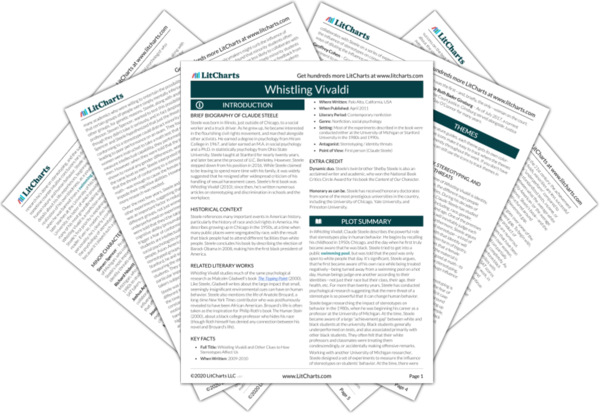Identity, Stereotyping, and Identity Threats
The central theme of Whistling Vivaldi is identity, and, furthermore, the different ways people respond to each other’s identities. During his decades of research into social psychology, Claude Steele has studied many different forms of identity, including, race, gender, ethnicity, social orientation, class, and age. One of the premises of his research is that human beings will inevitably judge each other on the basis of their identity. Furthermore, Steele argues that every unique identity has…
read analysis of Identity, Stereotyping, and Identity ThreatsThe Achievement Gap
While the key theme of Whistling Vivaldi is identity, Steele’s book is also an attempt to understand, and take a few more steps toward solving, a major problem facing America in the 21st century: the achievement gap. Across many different fields, minorities are less successful than white Americans—they “underperform” compared to white Americans. Whether on standardized tests, income, or employment, there is a “gap” between what the average white American and the average minority…
read analysis of The Achievement GapExperimentation and the Scientific Method
For more than three decades, Claude Steele has been studying the psychology of stereotyping. In Whistling Vivaldi, he revisits his long, successful career, showing how his thinking on the subject of stereotyping has evolved. At the same time, Steele shows readers how a good social psychologist uses research and experimentation to learn about the world, and walks readers through every step in the scientific method.
Like any successful scientific investigation, Steele’s research into stereotyping…
read analysis of Experimentation and the Scientific Method
Fighting Stereotypes
In Whistling Vivaldi, Claude Steele doesn’t just diagnose the problems of stereotyping. He also goes on to recommend some of the ways that teachers, parents, and policymakers might fight the influence of stereotyping.
The solutions that Steele recommends are centered around the same idea: stereotype cues can’t be eliminated entirely, but they can be minimized or canceled out. Steele argues that almost any environment, whether it’s a classroom or a subway, is bound to…
read analysis of Fighting StereotypesAutonomy and Freedom
In Whistling Vivaldi, Claude Steele advances a somewhat counterintuitive view of human autonomy and freedom. As he acknowledges upfront, most people would probably say that human beings are relatively independent: they have the ability to make free choices, mostly unaffected by the influences of other people or their environments. Prior to the late 1980s, Steele suggests, the social psychology community was generally committed to this traditional, commonsense view of free will. For example, when…
read analysis of Autonomy and Freedom











